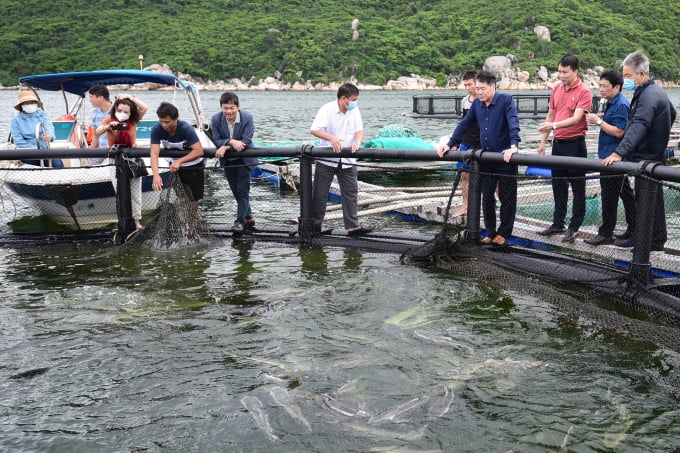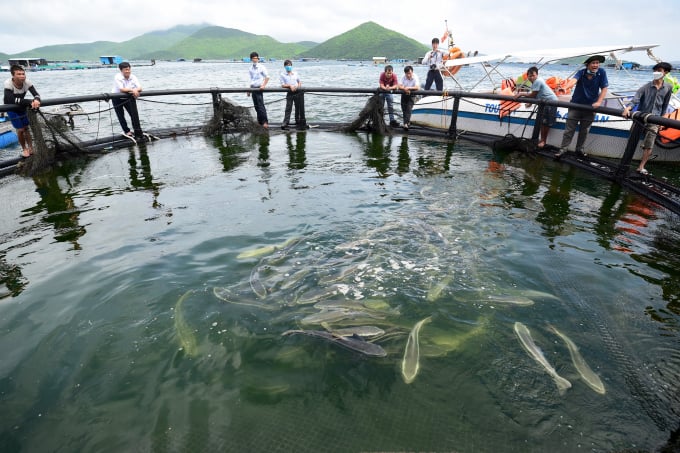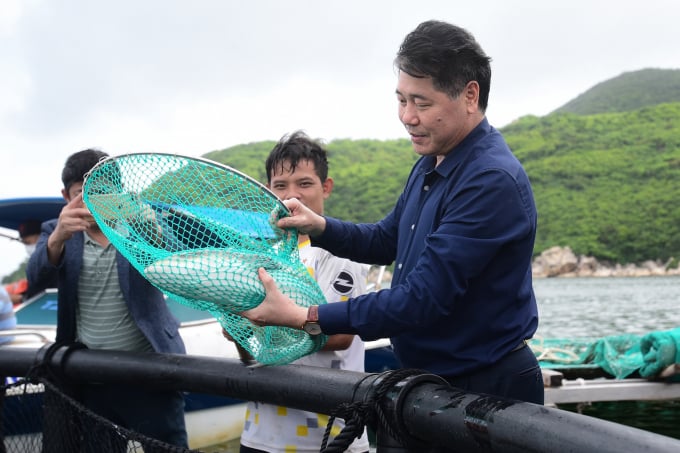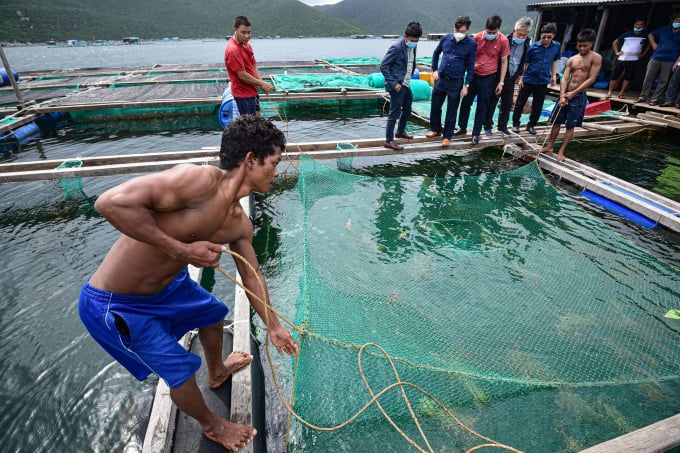June 18, 2025 | 07:18 GMT +7
June 18, 2025 | 07:18 GMT +7
Hotline: 0913.378.918
June 18, 2025 | 07:18 GMT +7
Hotline: 0913.378.918
On November 16 a delegation of the National Agricultural Extension Center (NAEC) came and visited the model of cobia fish farming using Norwegian technology-based DHPE cages in Van Phong Gulf, Van Ninh district (Khanh Hoa).

The delegation of the NAEC visited a closed-containment cobia fish farm. Photo: Tung Dinh.
Bai Tranh (in Van Thanh commune, Van Ninh district) in Phong Van Gulf surrounded by numerous islands and at a depth of 10 meters below the sea surface is suitable for developing marine aquaculture.
Here, Tran Ngoc Sy, a fish farmer in Van Luong commune (Van Ninh district) is raising 1,000 cobia fish in the high density polyethylene (HDEP) cages under the project “Developing Aquaculture in Norwegian technology - based floating HDEP cages”
HDPE cages are the globes with a diameter of 10 meter and each 500 cubic meter.
These cages are manufactured in Vietnam. Each costs VND180 million, a half of the price for imported cage of the same type.
Especially, survival rate of cobia fish raised in the closed- containment system is from 80-90%, 10% higher compared to the rate in traditional cages. After seven months, fish can reach harvest size, 5 kilogram/fish. However, due to the impact of Covid-19, the price is now low at only around VND120, 000 per kilogram. Sy decided to delay the harvest and wait until the Lunar New Year to sell his fish for higher prices as market demand is expected to go up in the year end.

It’s easy to harvest fish in the closed containment system. Photo: Tung Dinh.
Sy also said that raising fish in HDPE cages is not much different from farming in wood cages. With moderate size, the cages are suitable for smallholder fish farms. Along with that, it’s easy for farmers to harvest fish by hand without complex assistant tool. Particularly, since moving to farming fish in HDPE cages Sy no longer needs to worry about typhoon attacks.
Like Sy, Nguyen Xuan Hoa is raising cobia fish in HDPE cages. He excitedly said that raising fish in HDPE cages help fish farmers like him solve many problems they often encounter as the model has high survival rate of fish and better withstand storms. With achieved results, Sy said he will continue adopt this technology to lobster farming in the near future.
Huynh Kim Khanh, Director of Khanh Hoa Agricultural Extension Center said storm No.12 in 2017 landing in Khanh Hoa caused wreaks havoc on fish cage fish farmers in Van Phong Gulf.
With the fact that extreme weather events such as large storms are likely to become more frequent or more intense, the Center researched and carried out the project “Developing Aquaculture in Norwegian technology - based floating HDEP cages” with the support of the NAEC.

After seven months, cobia fish reach harvest size, around 5 kg/ fish. Photo: Tung Dinh.
Under the project, the center will raise cobia fish in six HDPE cages from 2020 to 2022. In 2020, the first HDPE cage was installed and produced 5 tons of cobia fish with a profit of VND100 million after 10 months of breeding. In 2021, the center has continued to put two more HDPE cages into operation. In 2022, three more cages will be added. These cages will act as a performance model for farmers in Van Phong come to visit and learn.
"Fish farming in HDPE cages not only helps protect environment but also reduce deforestation. Particularly HDPE cages can withstand storms with strong wind of level 10 or more. Moreover, the system creates good conditions for the growth of fish while reducing disease infections," Huynh Kim Khanh said.
Khanh added that Khanh Hoa provincial authorities planned to change from traditional wooden cages to HDPE cages in the near future. Accordingly, all of the province's wooden fish cages will be replaced with HDPE cages by 2030.
To achieve this goal, Khanh Hoa agricultural authorities will develop policies to support fish farmers to switch to floating HDPE cages.

Khanh Hoa province will gradually change from traditional wooden cages to HDPE cages to ensure safety in the tropical cyclone season. Photo: Tung Dinh.
Le Quoc Thanh, Director of the NAEC said the high density polyethylene (HDPE) cages are widely used in modern-industrial marine aquaculture in many parts of the world in particular Norway, a country with a large area of marine farming. Meanwhile most marine farming facilities in Vietnam are small scale making it difficult to apply the technology.
"So, we made some changes for example reducing the size of the globes and adjusting production process to be suitable to producing conditions in Vietnam," Thanh said.
Le Quoc Thanh said HDPE cage fish farming model is useful and should be replicated to the localities with marine farming. Therefore, the center is planning to organize forums to bring the technology closer to fish farmers.
According to Huynh Kim Khanh, the project has been carried out for two year so far this year. Seeing the benefits of the project many fish farmers in Van Phong Gulf learned and followed the model. Up to now there are 100 floating HDPE cages installed in the region. Besides, many enterprises outside Khanh Hoa have come and invested in the closed-containment fish farming system instead of wooden cages.
To make Norwegian technology-based HDPE cages affordable for local fish farmers, Vietnamese researchers changed some materials used in the cages. Thereby, the price for each HDPE caged manufactured in Vietnam is reduced by 50% compared to the cages imported from Norway.
Translated by Mai Tham
/2025/06/17/3942-2-143243_548.jpg)
(VAN) Recently, in Sweden, the Secretary of the Binh Dinh Provincial Party Committee presented the Investment Registration Certificate for the 'Polyester Fabric Recycling Complex' project to SYRE Impact-AB Company.
/2025/06/12/3721-2-202745_83.jpg)
(VAN) TH made an impression at Seoul Food 2025 with its line of natural beverages, paving the way for Vietnamese food products to enter the South Korean market.

(VAN) Soc Trang's success in rice exports stems from a strategy of developing fragrant and specialty rice cultivation areas and standardizing production toward low-emission practices.
/2025/06/11/1311-5-120811_839.jpg)
(VAN) The pig farming industry is facing the challenge of comprehensive restructuring to meet requirements for quality, safety, traceability, and market expansion both domestically and for export.

(VAN) Vietnam considers participating in ALGROALBA in order to expand agricultural production, coordinate the assessment and effective exploitation potential land.
/2025/06/05/5314-1-184727_407.jpg)
(VAN) From seemingly worthless fish scales and skin, enzymes and lactic ferments can transform by-products into peptides, opening a sustainable, effective business direction and elevating Vietnamese seafood.

(VAN) TTC AgriS and IFC signed a strategic partnership to develop a sustainable agricultural value chain, aiming to achieve the Net Zero target by 2035.